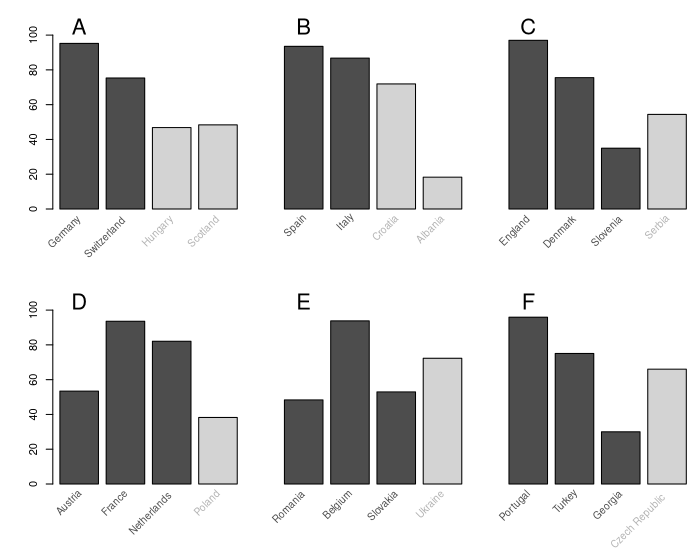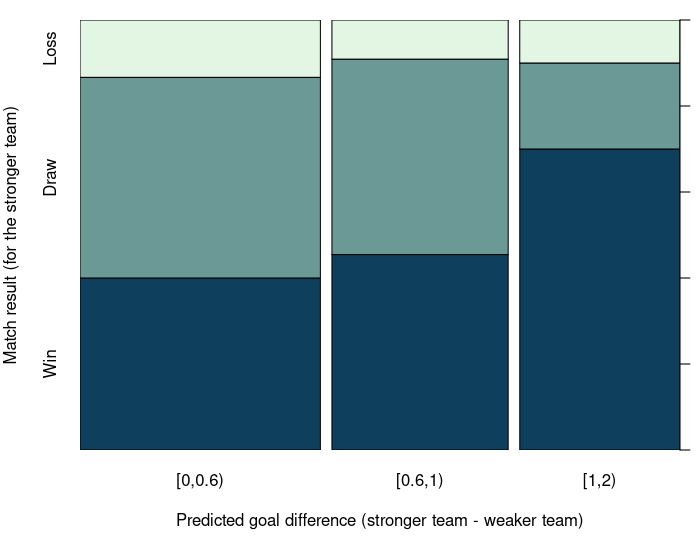Evaluation of the UEFA Euro 2024 group stage forecast
How surprising was the group stage?
This week the group stage of the UEFA Euro 2024 was concluded so that all pairings for the round of 16 are fixed now. Therefore, today we want to do address two questions regarding our own probabilistic forecast for the UEFA Euro 2024 based on a ensemble machine learning model that we have published prior to the tournament:
- How good were the predictions for the group stage? Were the actual outcomes surprising?
- How does the outcome of the group stage change the predicted winning probabilities for the tournament?
TL;DR
- All of our predictions worked quite well and most results were within the expected range of random variation. All tournament favorites proceeded to the round of 16 and mostly the weaker teams dropped out of the tournament.
- The biggest surprise was probably that Austria not only proceeded to the round of 16 but ranked first in arguably the strongest Group D, even surpassing France.
- Smaller surprises were that Croatia dropped out in Group B, that Belgium came second behind Romania in Group E, and that Georgia prevailed in Group F.
- However, some of the more interesting surprises did not really have big consequences, yet, in particular the poor scoring of top favorites France and England. Both of the teams made it to the knockout stage and it will be very interesting to see whether they will be able to boost their performance in the next game(s)!
- If England is indeed able to unleash their full potential, they will profit most from the group stage because all the other top favorites (in particular France) are in the other arm of the tournament draw now.
Group stage results
First, we look at the results in terms of which teams successfully advanced from the group stage to the round of 16. The barplots below shows all teams along with their predicted probability to proceed to the round of 16, in the observed ranking order, with the color highlighting which teams advanced to the knockout stage.

Clearly, all group favorites made the cut and mostly teams with lower probabilities dropped out. It may seem somewhat surprising that some of the weaker teams (especially Georgia) “survived” the group stage but with four out of six third-ranked teams advancing to the round of 16 this is not completely unexpected. The results in Groups D and E are probably more surprising: Austria came first in Group D and top favorite France only second. Similarly, Romania took the group victory in Group E behind the higher-ranked team from Belgium.
Match results
Next, we take a closer look at the 36 individual group-stage matches to check whether we had any major surprises. The stacked bar plot below groups all match results into three categories by their predicted goal difference for the stronger vs. the weaker team.

In the first bar the stronger team was predicted to be only slightly better, with 0 to 0.6 more predicted goals on average. In this bar we see that the stronger team won less than half of the matches (6 out of 15) while the other matches were either lost (2 matches) or ended in a draw (7 matches). Thus, the distribution roughly matches the predictions albeit the number of draws is somewhat higher than expected.
The picture is similar in the second bar where the predicted goal difference for the stronger team was between 0.6 and 1. The stronger team won 5 out of 11 matches, lost 1, and more than expected (5) ended in a draw.
Only in the last bar with the highest predicted goal differences (between 1 and 2 goals) there were fewer draws (2 out of 10). Here the distribution matches closely the expectations with 7 wins for the stronger team and only 1 loss.
As a final evaluation we check whether the observed number of goals per team in each match conforms with the expected distribution based on the Poisson model employed. This is brought out graphically by a so-called hanging rootogram.

The red line shows the square root of the expected frequencies while the “hanging” gray bars represent the square root of the observed frequencies. This shows that the predictions conform closely with the actual observations. There were only a few more occurrences of single goals and fewer results with four goals (none) than expected in our forecast.
Updated knockout stage predictions
Finally, we want to look ahead and explore how the realized tournament draw based on the group stage results changes the predicted winning probabilities for the UEFA Euro 2024. We do so under the assumption that all results so far are within the range of random variation and that we do not need to adapt the predictions for all possible matches. In other words, the simulation is based on the expectation that especially the top favorites France and England can still reach their full potential in the upcoming matches.
Simulating the knockout stage 100,000 times then leads to the following winning probabilities for the tournament. (The barplot preserves the ordering of the teams from the original prediction.)

This shows clearly that England profits most and increases its winning probability for the title to 22.1% (from 16.7%). For the other five top teams France, Germany, Spain, Portugal, and the Netherlands the winning probabilities are almost equal now and all around 13%. Four of these five teams are now all in the same arm of the tournament (which has also been dubbed the “shark tank” in the media) and it will certainly be exciting who will eventually make it to the final. In the other arm England and the Netherlands are now the teams with the highest winning probability but we should keep in mind that Austria has already beaten the Netherlands once. Only the next matches will show whether they will be able to do it again, should both teams be able to advance to the quarterfinal.
In any case, the most exciting part of the UEFA Euro 2024 is only starting now and we can all be curious what is going to happen. Everything is still possible!